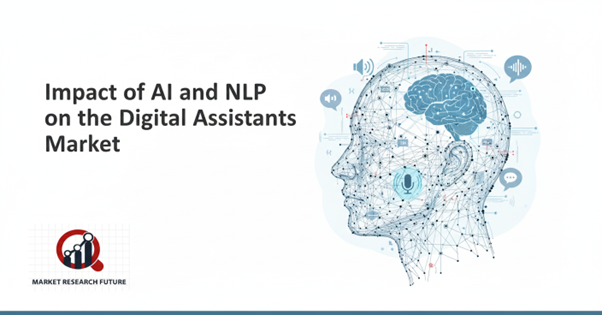Impact of AI and NLP on the Digital Assistants Market

The Digital Assistants Market has changed quickly thanks to progress in Artificial Intelligence (AI) and Natural Language Processing (NLP). These technologies have changed how digital assistants understand, talk to, and help users.
They have also made digital assistants smarter, more intuitive, and able to do more complicated jobs. Artificial intelligence (AI) and natural language processing (NLP) are changing the way people use digital assistants in everything from smartphones and smart speakers to business apps.
Digital Assistants and NLP
Natural Language Processing makes it easier for digital assistants to understand what people are saying. These systems can understand orders, answer questions, and have meaningful conversations thanks to NLP. Digital helpers can give better answers by knowing the situation, the person's feelings, and their goal, which makes the user happier.
Advanced NLP algorithms also handle multiple languages, which helps digital assistants serve people all over the world and breaks down language barriers in both consumer and business settings.
Personalization based on AI
With artificial intelligence, digital helpers can learn from how people use them and how they behave. AI programs look at past data to guess what users will want, what questions they will have, and how to best help them.
Digital assistants can, for example, suggest reminders, set up meetings, or suggest goods based on what the person wants. Personalization at this level makes users more interested and builds trust, making digital assistants necessary tools for both personal and business productivity.
Improved Automation and Efficiency
AI and NLP make it possible for digital assistants to do boring jobs automatically, giving users more time to do more important things. Digital assistants make daily tasks easier by taking care of things like emails and calendars and running smart home devices.
In business settings, AI-powered assistants answer questions from customers, give real-time information, and help workers make decisions. This makes operations more efficient and reduces the amount of work that human staff have to do.
Internet of Things and smart devices
The Internet of Things (IoT) and AI, and NLP working together have made digital helpers even more useful. These assistants can now use speech commands or automated triggers to control devices that are connected to them, like lights, thermostats, and security systems. This integration makes an intelligent ecosystem that lets users easily handle multiple devices. This makes things easier and strengthens the role of digital assistants in smart environments.
What the Future Holds for the Digital Assistants Market
New developments in AI and NLP will shape the future of the market for digital helpers. Conversational AI is supposed to get smarter and more human-like over time, able to handle complicated conversations and understand complex situations.
As machine learning and deep learning get better all the time, predictions will be more accurate and faster. Also, combining augmented reality (AR) and virtual reality (VR) settings could make assistant experiences that are more immersive and interactive, opening up new ways to use them for fun, learning, and business.
Final Thoughts on the Digital Assistants Market
Most of the growth and change in the digital helpers market can be traced back to AI and NLP. These technologies are changing how people use digital assistants by letting them learn more, interact with them in a more personal way, automate tasks, and connect to smart devices.
As AI and NLP keep getting better, digital helpers will become smarter, more proactive, and more necessary. They will drive innovation in both the consumer and business sectors.